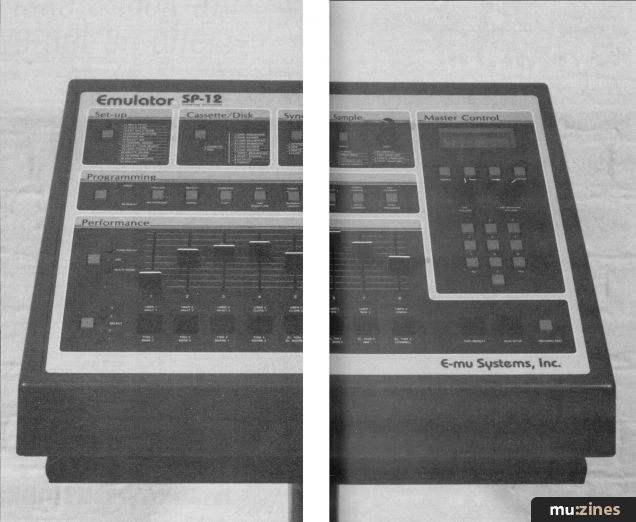Magazine Archive
Home -> Magazines -> Issues -> Articles in this issue -> View
Emulator SP12 Updates | |
Article from Electronics & Music Maker, May 1986 | |
Paul Wiffen peers inside the latest SP12 to find a host of clever modifications: they help keep the E-mu machine at the top of the beat-box tree.

It is customary, in this era of planned obsolescence, for consumer products to be introduced, advertised, sold, discontinued and finally replaced over an incredibly short period of time.
A new hi-tech musical instrument, for instance, can now expect a lifespan of no more than a couple of years, if it's lucky. During that time, it may enjoy a fair amount of popularity among musicians and technicians. It may even break sales records and make its manufacturers a small fortune. But almost everywhere, all that success goes by the wayside as soon as a better product has been developed and is ready to be foisted on the unsuspecting public. Almost everywhere, that is, except at a minority of enlightened music houses who have realised the value of introducing a machine, and then improving it stage by stage, instead of replacing it with something totally different.
One of those enlightened companies - from where I'm sitting, anyway - is E-mu Systems. In the nine months since we reviewed their Emulator SP12 sampling drum box, the Santa Cruz people have done more than simply rest on their laurels. Apart from moving 10 miles into the mountains to the picturesque but inaccessible Scotts Valley, they've been beavering away to keep the SP12 at the forefront of the sampling percussion field.
The first update, mentioned in our original review, was the Turbo kit. This expands the maximum sample time from just under two seconds on the base model to five seconds. Obviously, this means you can record percussion sounds that have naturally longer envelope times (like cymbal crashes) and sounds that have been treated with reverb, say.
Alternatively, you can use the extra memory in conjunction with one of the newer software improvements to go beyond the eight user sample locations originally provided for. By dexterous use of the new Copy Sound facility, you can spread 32 of your own sounds across the SP12's four banks, so that an entire drum pattern can bear witness to your sampling prowess. This facility should prove even more useful if the rumoured 'Rambo' update (giving 15 seconds' worth of sample memory) comes to pass.
The range over which pitched samples can be played has also been increased by the later software versions, and now gives you a choice between Low, Mid and Hi. Creating sounds which don't betray their sampled origins has never been easier.
The latest version of software, catchily titled 2.4, also provides for compatibility with the JL Cooper MIDIdisk, an all-purpose Stateside device of considerable worth. With the 2.4 software, you're no longer forced to watch your hair turn grey whilst waiting for a tape recorder or Commodore disk drive to save and load sounds and sequences. The Cooper drive works considerably faster than Commodore's legendary tortoise, and does so with a lot less racket, too. However, the MIDIdisk doesn't come all that cheap (listing at just under a $1000 in its country of origin), and until someone starts importing Mr Cooper's worthy (if a little pricey) efforts into the UK, you'll have to send off to the States for it.
The most recent news on the hardware front also concerns something that isn't actually being produced by E-mu themselves - though again, the new software contains the necessary operating system for it to work.
The devastatingly simple modification in question is the brainchild of Riley Smith, E-mu's Service Manager. In simple terms, it allows the sample input to be used to trigger any one of the factory or user sounds from an audio signal, like a sound off tape or another instrument, in real time. All you do to facilitate this is pull up the pot on the sample module, which then sets the triggering threshold. Ingenious, and frighteningly easy to accomplish.
On top of all this, E-mu have done a bit of export restructuring so that the Turbo version now lists at just £2500 plus VAT. It's not going to put Yamaha and Casio designers out of a job, but it does make the SP12 better value than ever. For me, there is no real alternative.
(Contact Details)
Also featuring gear in this article
E-mu SP12
(12T Aug 85)
Emulator SP-12 - Rhythmcheck
(IM Oct 85)
Me and My E-mu - Emulator SP12
(EMM Sep 85)
Browse category: Drum Machine > Emu Systems
Featuring related gear
E-mu SP1200 - Sampling Percussion System
(SOS Oct 87)
This Year's Model - Korg DSM1 & E-mu SP1200
(MT Jan 88)
Browse category: Drum Machine > Emu Systems
Publisher: Electronics & Music Maker - Music Maker Publications (UK), Future Publishing.
The current copyright owner/s of this content may differ from the originally published copyright notice.
More details on copyright ownership...
Review by Paul Wiffen
Previous article in this issue:
Next article in this issue:
Help Support The Things You Love
mu:zines is the result of thousands of hours of effort, and will require many thousands more going forward to reach our goals of getting all this content online.
If you value this resource, you can support this project - it really helps!
Donations for April 2024
Issues donated this month: 0
New issues that have been donated or scanned for us this month.
Funds donated this month: £7.00
All donations and support are gratefully appreciated - thank you.
Magazines Needed - Can You Help?
Do you have any of these magazine issues?
If so, and you can donate, lend or scan them to help complete our archive, please get in touch via the Contribute page - thanks!







